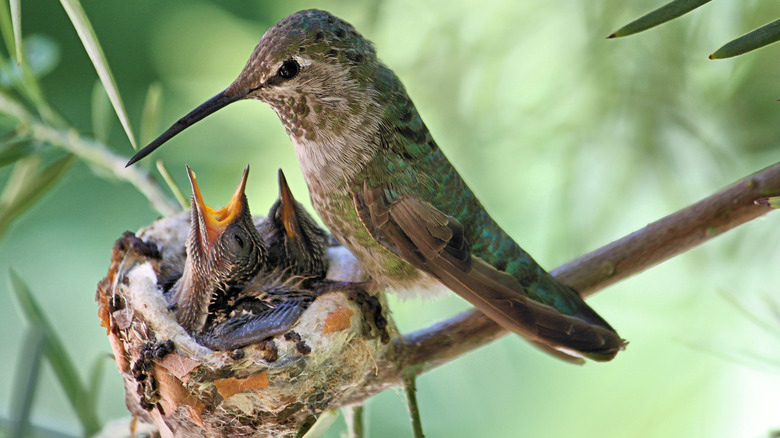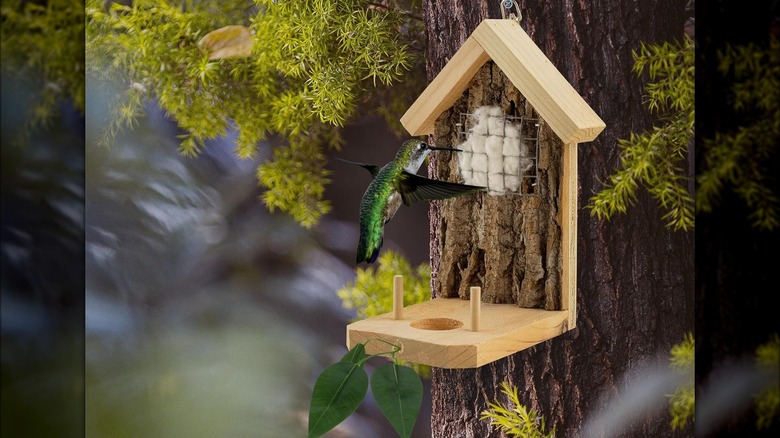How To Build A Hummingbird Nest Box They Will Actually Use And Like
We may receive a commission on purchases made from links.
Humans' fascination with the whimsical life of birds goes back literal centuries. The rarer or more unusual the bird, the more desirable it becomes to bird watchers. It's no wonder, then, that ornithophiles everywhere seem to share the goal of creating their own successful nesting boxes for hummingbirds. Unlike popular songbirds, hummingbirds won't simply inhabit whichever birdhouse you happen to mount for them (no matter how expensive or elaborate). You can try to tempt them with a carefully crafted nesting box; however, it isn't easy to get them to abandon their preferred treetops for a manmade setup. If you can create a nester catered to their specific nesting style by providing a high, open platform with supports and nesting materials, though, it can be done.
The simple fact is that hummingbirds aren't cavity nesters like most of the birds that frequent your yard. Instead, these tiny nectar sippers build cup nests. These amazing, flexible cup-shaped nests are tiny, usually just over an inch in diameter, and placed up to 90 feet above ground and secured to tree branch forks using natural materials like plant fibers and spiderweb silk. Consider this your guide to building a platform that meets their nesting needs.
Against all odds: building a hummingbird nesting box
The key to building a nesting box that hummingbirds will actually use is to intentionally recreate the conditions they naturally seek out for nest building. Since these birds build cup nests, any nesting box meant for them should be more of an open platform than an actual enclosed box. Building a hummingbird nesting platform is similar to building a birdhouse but without the front and side walls. You'll need some scrap or reclaimed wood and a couple of small twigs or dowels, nails, a drill, and wood glue. Start with the back of the "house" by finding or cutting a board that's about 9 inches tall and 4 inches wide.
To the bottom of the backboard, attach another board that is about 10 inches long and 4 inches wide to serve as the nesting platform. Drill a small hole in the center of this board for drainage and then attach two small twigs or dowels just over an inch apart to support either side of a theoretical nest. Then, cut two final wood pieces to size and secure them with wood glue and nails to create an A-frame roof that hangs over about ⅓ of the platform. Hang your completed nester at least 10 feet off the ground in a covered and discreet area that offers some protection from wind, rain, and birds that don't mix well with hummingbirds. This might be under your home's roof peak, on the side of a tree trunk, or on a designated pole.
Pre-built options, attractants, and nesting materials
Managing to build a nesting platform that hummingbirds will actually use can be difficult. If you're more interested in the birdwatching than the building project, you do have the option of purchasing a pre-built product specifically designed to attract nesting hummingbirds. Some of these products — like Uncle Dunkels Handcrafted Backyard Hummingbird Nester — include features like natural kiln-dried poplar bark, a refillable wire grid that holds nesting materials (prefilled with organic cotton), and an artificial limb for perching. You can purchase this particular nester on Amazon for $23.99.
Whether you build your own nesting platform or purchase one, you can increase your likelihood of success by providing local hummingbirds with extra nesting materials (never leave dryer lint out for birds). These birds build their unique flexible cup nests using soft fluffy fibers like cotton, moss, and spiderweb silk. Place these or similar items near your nesting box or attached to its backboard behind a small piece of wire mesh.
Planting native flowers like trumpet vines (these musical-sounding flowers are also called hummingbird vines), agastaches, and columbines will attract the hummingbirds to your yard and provide them with a food source that will encourage them to stick around. There's no guarantee that hummingbirds will use the nesting platform that you build or purchase, but providing one as close to what they would naturally build as possible gives you the best chance.

